Analysis of Land Use Developments Along the LRT Line (Case Study: Polresta, Jakabaring and DJKA Station’s)
DOI:
https://doi.org/10.32832/astonjadro.v12i3.9442Keywords:
land use; transportation; South Sumatera LRT; before-after analysis; arcgis.Abstract
Transportation has become a basic need that plays an important role in people's lives. To reach a place, a high level of accessibility is required. A high level of accessibility will affect the number of people coming to an area. Many people will affect the number of activities that require land. Therefore, this study aims to analyze land use trends that occurred in the time period before and after the South Sumatra LRT. LRT or Light Rail Transit is a type of public transportation in the form of light rail operating in urban areas. LRT is the first light rail transportation in Indonesia right in Palembang City. Therefore, it is interesting to see its relation to land change along the LRT route. This research was conducted at three stations which were case studies, namely Polresta, Jakabaring and DJKA stations. This station was chosen because it is in Jakabaring. Jakabaring was chosen as the research area because it is a sub-district which is located on the border with other regencies but is still passed by the LRT. This research is a qualitative research using the overlay before-after analysis method through spatial data. This research uses the help of Archgis software, through Intersect tools and multiple ring buffers. The results of the analysis are then used as data for further analysis using a pivot table in excel. The results of this analysis prove that there is a tendency for changes in land use within a certain radius. The trend is in the form of changes in land from swamps or paddy fields to deserted, trade and services as well as offices.
References
Aminah, S. (2012). Jurnal Teknik Sipil Untan. Teknik Sipil Untan, 12(DESEMBER), 175–176.
Bettencourt, L. M. . (2017). The kind of problem a city is. Political Economy, Diversity and Pragmatism: Critical Essays in Planning Theory: Volume 2, 137–157. https://doi.org/10.4324/9781315246543-14
Biomantara, K., & Herdiansyah, H. (2019). Peran Kereta Api Indonesia (KAI) sebagai Infrastruktur Transportasi Wilayah Perkotaan. Cakrawala, 19(1), 1–8. Retrieved from http://ejournal.bsi.ac.id/ejurnal/index.php/cakrawala
Daniels, R., & Mulley, C. (2013). Explaining walking distance to public transport: The dominance of public transport supply. Journal of Transport and Land Use, 6(2), 5–20. https://doi.org/10.5198/jtlu.v6i2.308
Debrezion, G., Pels, E., & Rietveld, P. (2007). The impact of railway stations on residential and commercial property value: A meta-analysis. Journal of Real Estate Finance and Economics, 35(2), 161–180. https://doi.org/10.1007/s11146-007-9032-z
Dewo Kusumaningrat, M., Subiyanto, S., & Yuwono, B. D. (2017). Analisis Perubahan Penggunaan dan Pemanfaatan Lahan terhadap Rencana Tata Ruang Wilayah Tahun 2009 dan 2017 (Studi Kasus: Kabupaten Boyolali). Jurnal Geodesi Undip, 6(4), 443–452.
Fadli, M. R. (2021). Memahami desain metode penelitian kualitatif. Humanika, 21(1), 33–54. https://doi.org/10.21831/hum.v21i1.38075
Geurs, K. T., & van Wee, B. (2004). Accessibility evaluation of land-use and transport strategies: Review and research directions. Journal of Transport Geography, 12(2), 127–140. https://doi.org/10.1016/j.jtrangeo.2003.10.005
Hadihardja, P. I. J. (1997). Sistem Transportasi (Tim Penyusun) (z-lib.org). Universitas Gunadarma, pp. 1–118.
Intan M. Harjanti*, Khristiana. D. Astuti, Pangi, R. Yesiana, P. Anggraini, B., & Septiarani. (2020). Space Structure and Pattern of Kecamatan Jumo, Kabupaten Temanggung. 1(2), 12–17.
Kadir Abdul. (2006). Dalam Pertumbuhan Ekonomi Nasional. Transportasi Peran Dan Dampaknya Dalam Pertumbuhan Ekonomi Nasional, 1, 121–131.
Marcus Tukan, Hozairi, P. T. B. (2023). Transportasi Kepulauan Berbasis Ruang Untuk Mendukung Tol Laut.
Pramana, A. Y. E. (2018). Tingkat Aksesibilitas Transportasi Publik Di Kota Yogyakarta. Reka Ruang, 1(1), 7–16.
Putri, F. M., Yulanda, N., & Desga, W. (2016). Permodelan Bangkitan Perjalanan di Nagari Siguntur, Nagari Barung-Barung Belantai, dan Nagari Nangalo Kecamatan Koto XI Tarusan Kabupaten Pesisir Selatan. Jurnal Penelitian Transportasi Multimoda , 14(2), 77–82.
Rahmat, P. S. (2009). Penelitian Kualitatif. Journal Equilibrium, pp. 1–8. Retrieved from yusuf.staff.ub.ac.id/files/2012/11/Jurnal-Penelitian-Kualitatif.pdf
Ransom, M. R. (2018). The effect of light rail transit service on nearby property values: Quasi-experimental evidence from seattle. Journal of Transport and Land Use, 11(1), 387–404. https://doi.org/10.5198/jtlu.2018.1096
Resiwiyasa, Novie Fitria., I Gede Sugiyanto., I. L. N. (2012). 1) , 2) , 3).
Setiawan, Y., & Yoshino, K. (2020). Spatial modeling on land use change in regional scale of Java Island based-on biophysical characteristics. Jurnal Pengelolaan Sumberdaya Alam Dan Lingkungan (Journal of Natural Resources and Environmental Management), 10(3), 511–523. https://doi.org/10.29244/jpsl.10.3.511-523
Shofian Edy Harianto Bongso, Theo K.Sendow, M. R. E. M. (2019). Studi Potensi Jaringan Light Rail Transit (Lrt) Dan Konstruksi Perkerasan Rel (Studi Kasus: Koridor Kota Manado Kecamatan Malalayang, Kecamatan Sario, Kecamatan Wenang). Jurnal Sipil Statik, 7(10), 1317–1328.
Silondae, S. (2016). Keterkaitan Jalur Transportasi Dan Interaksi Ekonomi Kabupaten Konawe Utara Dengan Kabupaten/Kota Sekitarnya. Jurnal Progres Ekonomi Pembangunan, 1(1), 49–64.
Tamin. (2000). Perencanaan dan Pemodelan Transportasi.
Tamin, O. Z. (2007). Menuju Terciptanya Sistem Transportasi Berkelanjutan di Kota-Kota Besar di Indonesia. Jurnal Transportasi, 7(2), 87–104.
Downloads
Published
How to Cite
Issue
Section
License
Copyright (c) 2023 ASTONJADRO

This work is licensed under a Creative Commons Attribution-ShareAlike 4.0 International License.
Paper submitted to ASTONJADRO is the sole property of the Astonjadro Journal. Unless the author withdraws the paper because he does not want to be published in this journal. The publication rights are in the journal Astonjadro.ASTONJADRO
LICENSE
This work is licensed under a Creative Commons Attribution-ShareAlike 4.0 International License.
Based on a work at http://ejournal.uika-bogor.ac.id/index.php/ASTONJADRO













